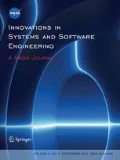Abstract
Sequence Diagrams (SDs) are one of the most popular elements of the UML notation to model the dynamics of systems. However, the graphical representation of basic SDs suffers from an inherent ambiguity that has led to different definitions in UML 1.x and in UML 2.0. This ambiguity paves the way for the consideration of several semantics for basic SDs. The paper studies four of these semantics and shows to what extent their differences for a given SD (that is the amount of ambiguity of this diagram) comes from its structural properties (linearity, local control and local causality). The fulfilment of these properties can serve as a measure of the ambiguity of a SD, and thus the attention to be paid at its validation.
Similar content being viewed by others
References
ITU-T recommendation Z.120. Message sequence charts (MSC’96), May 1996. http://www.itu.int
Mauw S, Reniers M (2001) A process algebra for interworkings Chap 19. Elsevier, Amsterdam, pp 1269–1327
Damm W, Harel D (2001) LSCs: breathing life into message sequence charts. Formal Methods Syst Des 19(1): 45–80
Object Management Group (2003) UML 1.5 specification. http://www.omg.org
International Organization for Standardization (2005) ISO/IEC 19501 specification. http://www.iso.org, also referred as Unified modeling language specification, version 1.4.2 formal/05-04-01
Object Management Group (2005) UML 2.0 specification. http://www.omg.org
Cardoso J, Sibertin-Blanc C (2002) An operational semantics for UML interaction: sequencing of actions and local control. Eur J Autom Syst APII-JESA 36: 1015–1028 (Hermès-Lavoisier)
Sibertin-Blanc C, Tahir O, Cardoso J (2005) Interpretation of UML sequence diagrams as causality flows. In: Advanced distributed systems, 5th international school and symposium (ISSAD). LNCS, vol 3563. Springer, Heidelberg, pp 126–140
Vaughan RP (1986) Modeling concurrency with partial orders. Int J Parallel Program 15(1): 33–71
Sibertin-Blanc C, Hameurlain N, Tahir O (2008) Ambiguity and structural properties of basic sequence diagrams. Internal Report, IRIT, University Toulouse 1
Alur R, Etessami K, Yannakakis M (2000) Inference of message sequence charts. In: Proceedings of the 22nd international conference on software engineering (ICSE). ACM Press, New York, pp 304–313
Uchitel S, Kramer J, Magee J (2001) Detecting implied scenarios in message sequence chart specifications. In: Proceedings of the 9th European software engineering conference and 9th ACM SIGSOFT international symposium on the foundations of software engineering (ESEC/FSE’01). ACM, New York, pp 74–82
Aredo BD (2002) A framework for semantics of UML sequence diagrams in PVS. J Univers Comput Sci (JUCS) 8(7): 674–697
Störrle H (1999) A Petri-net semantics for sequence diagrams. GI/ITG Fachgespräch Formale Beschreibungstechniken für verteilte Systeme (FBT’99)
Mauw S, Reniers MA (1999) Operational semantics for MSC’96. Comput Netw ISDN Syst 37(17): 1785–1799
Grabowski J, Graubmann P, Rudolph E (1993) Towards a Petri net based semantics definition for message sequence charts. In: Proceedings of the 6th SDL forum (SDL’93). North-Holland, Amsterdam, pp 179–190
Owre S, Shankar N, Rushby JM (1992) PVS: a prototype verification system. In: Proceedings of the 11th international conference on automated deduction (CADE’92). LNCS, vol 607. Springer, Heidelberg, pp 748–752
Xiaosha-n L, Zhiming L, Jifeng H (2004) A formal semantics of UML sequence diagram. In: Proceedings of Australian software engineering conference, ASWEC 2004. IEEE CS, New York, pp 168–177
Knapp A (1999) A formal semantics for UML interactions. In: Proceedings of the second international conference on the unified modeling language. LNCS, vol 1723. Springer, Heidelberg, pp 116–130
Gehrke T, Goltz U, Wherheim H (1998) The dynamic models of UML: towards a semantics and its application in the development process. Hildesheimer Informatik-Bericht 11/98, Institut für Informatik, Universitat Hildesheimer
Manna Z, Pnueli A (1992) The temporal logic of reactive and concurrent systems. Specification, vol 1 . Springer, New York
Cengarle MV, Knapp A (2004) UML 2.0 Interactions: semantics and refinement. In: Proceedings of the third international workshop on critical systems development with UML (CSDUML’04,), pp 85–99. Technical Report TUM-I0415, Institut für Informatik, Technische Universität München
Störrle H (2003) Assert, negate and refinement in UML-2 interactions. Workshop on critical systems development with UML (CSDUML’03). Technische Universität München, Technical report TUM-I0317
Störrle H (2003) Semantics of interactions in UML 2.0. In: Proceedings of 2003 IEEE symposium on visual languages and formal methods (VLFM’03)
Author information
Authors and Affiliations
Corresponding author
Rights and permissions
About this article
Cite this article
Sibertin-Blanc, C., Hameurlain, N. & Tahir, O. Ambiguity and structural properties of basic sequence diagrams. Innovations Syst Softw Eng 4, 275–284 (2008). https://doi.org/10.1007/s11334-008-0063-2
Received:
Accepted:
Published:
Issue Date:
DOI: https://doi.org/10.1007/s11334-008-0063-2




